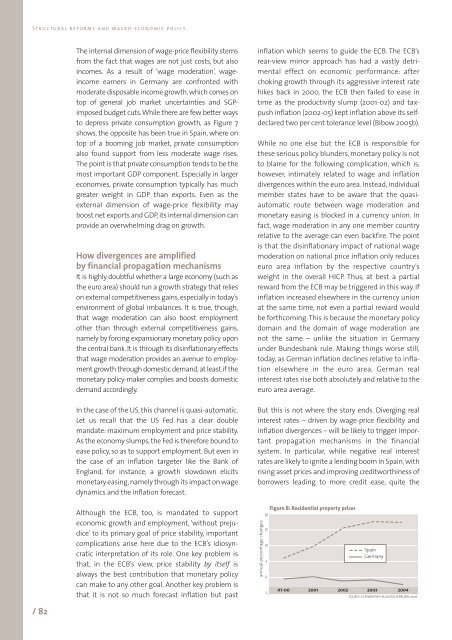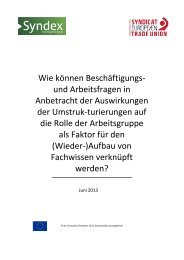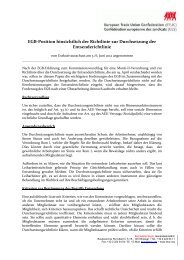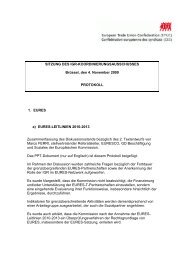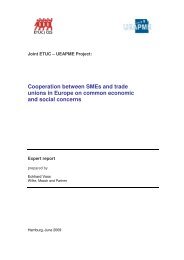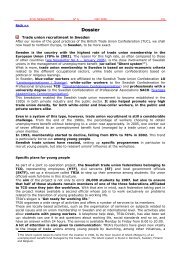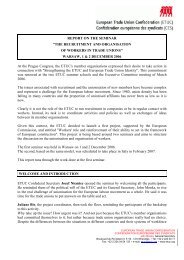Structural reforms and macro-economic policy - ETUC
Structural reforms and macro-economic policy - ETUC
Structural reforms and macro-economic policy - ETUC
You also want an ePaper? Increase the reach of your titles
YUMPU automatically turns print PDFs into web optimized ePapers that Google loves.
<strong>Structural</strong> <strong>reforms</strong> <strong>and</strong> <strong>macro</strong>-<strong>economic</strong> <strong>policy</strong><br />
/ 82<br />
The internal dimension of wage-price flexibility stems<br />
from the fact that wages are not just costs, but also<br />
incomes. As a result of ‘wage moderation’, wageincome<br />
earners in Germany are confronted with<br />
moderate disposable income growth, which comes on<br />
top of general job market uncertainties <strong>and</strong> SGPimposed<br />
budget cuts.While there are few better ways<br />
to depress private consumption growth, as Figure 7<br />
shows, the opposite has been true in Spain, where on<br />
top of a booming job market, private consumption<br />
also found support from less moderate wage rises.<br />
The point is that private consumption tends to be the<br />
most important GDP component. Especially in larger<br />
economies, private consumption typically has much<br />
greater weight in GDP than exports. Even as the<br />
external dimension of wage-price flexibility may<br />
boost net exports <strong>and</strong> GDP, its internal dimension can<br />
provide an overwhelming drag on growth.<br />
How divergences are amplified<br />
by financial propagation mechanisms<br />
It is highly doubtful whether a large economy (such as<br />
the euro area) should run a growth strategy that relies<br />
on external competitiveness gains, especially in today’s<br />
environment of global imbalances. It is true, though,<br />
that wage moderation can also boost employment<br />
other than through external competitiveness gains,<br />
namely by forcing expansionary monetary <strong>policy</strong> upon<br />
the central bank. It is through its disinflationary effects<br />
that wage moderation provides an avenue to employment<br />
growth through domestic dem<strong>and</strong>, at least if the<br />
monetary <strong>policy</strong>-maker complies <strong>and</strong> boosts domestic<br />
dem<strong>and</strong> accordingly.<br />
In the case of the US, this channel is quasi-automatic.<br />
Let us recall that the US Fed has a clear double<br />
m<strong>and</strong>ate: maximum employment <strong>and</strong> price stability.<br />
As the economy slumps, the Fed is therefore bound to<br />
ease <strong>policy</strong>, so as to support employment. But even in<br />
the case of an inflation targeter like the Bank of<br />
Engl<strong>and</strong>, for instance, a growth slowdown elicits<br />
monetary easing, namely through its impact on wage<br />
dynamics <strong>and</strong> the inflation forecast.<br />
Although the ECB, too, is m<strong>and</strong>ated to support<br />
<strong>economic</strong> growth <strong>and</strong> employment, ‘without prejudice’<br />
to its primary goal of price stability, important<br />
complications arise here due to the ECB’s idiosyncratic<br />
interpretation of its role. One key problem is<br />
that, in the ECB’s view, price stability by itself is<br />
always the best contribution that monetary <strong>policy</strong><br />
can make to any other goal. Another key problem is<br />
that it is not so much forecast inflation but past<br />
inflation which seems to guide the ECB. The ECB’s<br />
rear-view mirror approach has had a vastly detrimental<br />
effect on <strong>economic</strong> performance: after<br />
choking growth through its aggressive interest rate<br />
hikes back in 2000, the ECB then failed to ease in<br />
time as the productivity slump (2001-02) <strong>and</strong> taxpush<br />
inflation (2002-05) kept inflation above its selfdeclared<br />
two per cent tolerance level (Bibow 2005b).<br />
While no one else but the ECB is responsible for<br />
these serious <strong>policy</strong> blunders, monetary <strong>policy</strong> is not<br />
to blame for the following complication, which is,<br />
however, intimately related to wage <strong>and</strong> inflation<br />
divergences within the euro area. Instead, individual<br />
member states have to be aware that the quasiautomatic<br />
route between wage moderation <strong>and</strong><br />
monetary easing is blocked in a currency union. In<br />
fact, wage moderation in any one member country<br />
relative to the average can even backfire. The point<br />
is that the disinflationary impact of national wage<br />
moderation on national price inflation only reduces<br />
euro area inflation by the respective country’s<br />
weight in the overall HICP. Thus, at best a partial<br />
reward from the ECB may be triggered in this way. If<br />
inflation increased elsewhere in the currency union<br />
at the same time, not even a partial reward would<br />
be forthcoming. This is because the monetary <strong>policy</strong><br />
domain <strong>and</strong> the domain of wage moderation are<br />
not the same – unlike the situation in Germany<br />
under Bundesbank rule. Making things worse still,<br />
today, as German inflation declines relative to inflation<br />
elsewhere in the euro area, German real<br />
interest rates rise both absolutely <strong>and</strong> relative to the<br />
euro area average.<br />
But this is not where the story ends. Diverging real<br />
interest rates – driven by wage-price flexibility <strong>and</strong><br />
inflation divergences – will be likely to trigger important<br />
propagation mechanisms in the financial<br />
system. In particular, while negative real interest<br />
rates are likely to ignite a lending boom in Spain, with<br />
rising asset prices <strong>and</strong> improving creditworthiness of<br />
borrowers leading to more credit ease, quite the<br />
annual percentage changes<br />
20<br />
15<br />
10<br />
5<br />
0<br />
-5<br />
Figure 8: Residential property prices<br />
97-00 2001 2002<br />
Spain<br />
Germany<br />
2003 2004<br />
SOURCE: ECB MONTHLY BULLETIN, FEBRUARY 2006


